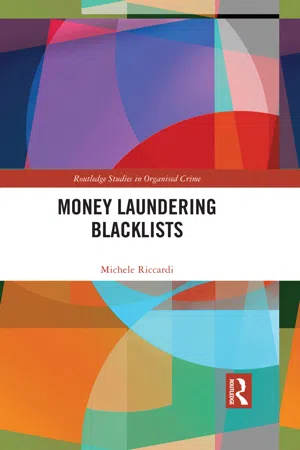1.1 Money laundering (and illicit financial flows)
Money laundering (ML) is widely acknowledged as “a way of hiding the proceeds of crime so that the authorities cannot take it back and so that offenders can use it to enjoy a more affluent lifestyle or to legitimize themselves and their assets” (Levi & Soudijn, 2020, p. 580). The objectives of ML are twofold: (a) hiding the (illicit) origin of the money and (b) hiding the beneficiary of this money and giving them an appearance of legitimacy. If these objectives are achieved, then criminals can enjoy the profits of their crimes.
From a legal perspective, building on the definitions provided by most anti-money laundering (AML) regulations worldwide, ML can be identified as the (a) transfer; (b) conversion; (c) concealment and disguise; or (d) acquisition, possession, and use of money or property that is knowingly (or suspected as being) illegal in origin, along with any other activity that attempts to facilitate, abet, aid, and support all of the above. This is, of course, a very broad definition, which clashes with the relatively limited amount of ML prosecutions (if compared to other serious crimes) which could be observed on a global scale.
Often the focus is placed on the ML process, which traditionally has been broken down into three phases: (i) placement, which is when illicit money is deposited/injected into the legal economy; (ii) layering (or justification), in which it is outdistanced from its origin through an array of strategies (e.g. shell companies, smurfing techniques, false invoices); (iii) integration, whereby the money is finally used for the desired purposes within the legitimate economy. A number of scholars have criticised this view on the grounds of being too simplistic and too sequential, due to the fact that the three phases are not always necessary, insofar as some of them work well with cash-based ML but not with other types of proceeds (Gilmour, 2020; Levi & Soudijn, 2020; van Duyne, 2013). As noted by some authors, most ML investigations are quite straightforward and do not necessarily involve financial specialists and complex schemes (Soudijn, 2018; Transcrime, 2018). Despite this, it remains unclear whether this is because ML schemes are simpler than they are often presumed to be or because police agencies are unable to trace more complex typologies.
The focus of this book is on cross-border ML, i.e. any ML scheme involving the employment of two or more jurisdictions. In the most straightforward scenario, a scheme in which proceeds are produced by some criminal activity in a origin country – let’s call it country i – and subsequently transferred, deposited, or concealed in another destination country – let’s call this country j. Transnational ML schemes are ordinarily more complex than this and are not comprehended in a bilateral relationship. Rather, they may entail the opening of bank accounts in a certain jurisdiction, the incorporation of firms in another jurisdiction, perhaps with the support of a law firm in a third jurisdiction, and the eventual return of the funds to the country of origin, likely through other countries, firms, and/or banks. In other words, in between the origin country i and destination country j, there are a number of “throughflow” countries that can be identified (Ferwerda et al., 2020). The global ML market sees some countries (usually, those producing the largest illicit proceeds) generating a demand for ML services, while others operate more on the supply side. Some specialise in providing banking services, others are market-leaders in company incorporation services, while others offer manifold cash-based integration opportunities. I will return to this when discussing the risk of ML at the country level.
Cross-border ML is closely associated with the issue of illicit financial flows (IFF). From a strictly legal perspective, IFF can be referred to as any transfer of money across countries, which is “earned, transferred or used” in direct contravention of existing law (Kar & Freitas, 2011). In other words, money that is (a) illegal in origin (e.g. drug trafficking or extortion) and/or (b) is moved in such a way that violates certain money transfer regulations (e.g. the maximum limits of importing/exporting cash) and/or (c) used for funding illegal activities (e.g. a terrorist group or for bribing a public official somewhere).
The concept of IFF has received considerable attention in extant policy debate, not only because it is at the centre of one of the United Nations (UN) Sustainable Development Goals (SDGs) (namely, 16.4 with its indicator 16.4.1) but also because it is so broadly and vaguely defined that it is employed (with different labels) by many researchers across many fields, including those economists who study how and where multinational companies shift their profits to minimise their tax burdens (Aziani, 2018; Cobham & Janský, 2017, for a review). Indeed, the first term in the concept of IFF – i.e. “illicit” and not “illegal” – encompasses a range of activities that extend beyond the criminal realm to include also “legally ambiguous transfers” (Reuter, 2017, p. 2), which, while not necessarily criminal in nature, are nevertheless deemed to be unethical, largely due to their detrimental effect on the development of disadvantaged countries (Blankenburg & Khan, 2012).
In this book, I focus on a specific subset of IFF, namely those originating from criminal (and not illicit) activities – better known as predicate offences. Moreover, I focus only on those flows geared towards laundering the money and not, for example, those aimed at either reinvesting the money in the same (or other) predicate offences or funding terrorist activities. I will therefore refer solely to ML (and ML risk) and not to terrorist financing, which ordinarily follows different strategies, has different drivers, and, as such, would warrant a wholly separate...
